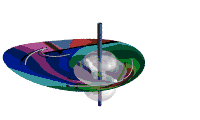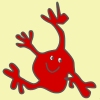
 |
This illustrattion was made for the annual report of the dutch heart foundataion (NHS). Due to space constrictions it was never used. The aim was to capture the purpose of the study in one image. Calcification of the mitral valve deminishes the flow and results in an increased pressure in the left atrium. The atrium increases in size and this leads to atrial fibrillation (shown as colored isochrones and the arrows). By inflation of a (double) balloon in the valve the stenosis is reduced, the pressure decreases and the fibrillation stops. A variation of this image was used as the cover for the thesis of J. Langerveld. |
| Technique: | Ray-tracing |
| Programs: | POV-ray |
 |
The cover of the thesis of J.M. ten Berg was made by his daughter Sanne (age 6). His thesis is titled 'oral anticoagulation in percutaneous coronary intervention'. When infating a balloon in a coronary artery to reduce a stenosis, the plaque and the arterial wall may be ruptured. Tissuefactors are then released in the blood and this may result in restenosis. To make the point that therefore anticoagulation before, during and after the percutaneous coronary intervention is nescessary, this animation was made in the style of Sanne. |
For this animation special programs were written in Matlab code to define and animate splines. Rendering was done by POV-ray. POV-ray is essentially 3D. Getting the lighting and the characters as flat as possible was quite a task in itself.
| Technique: | Ray-tracing |
| Programs: | POV-ray, Matlab |
| Technique: | Ray-tracing |
| Programs: | POV-ray, Matlab |
| Technique: | Ray-tracing |
| Programs: | POV-ray, Matlab |